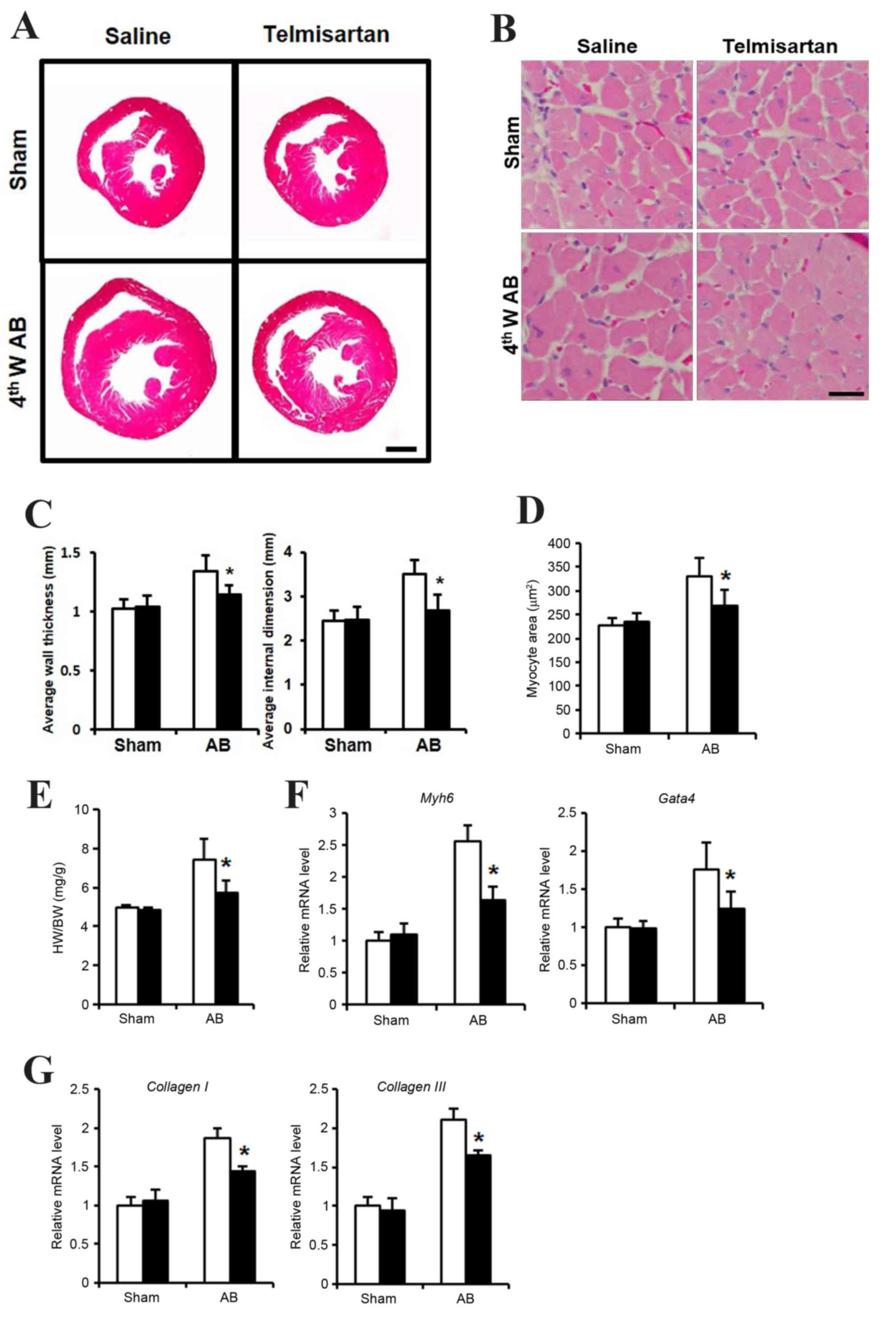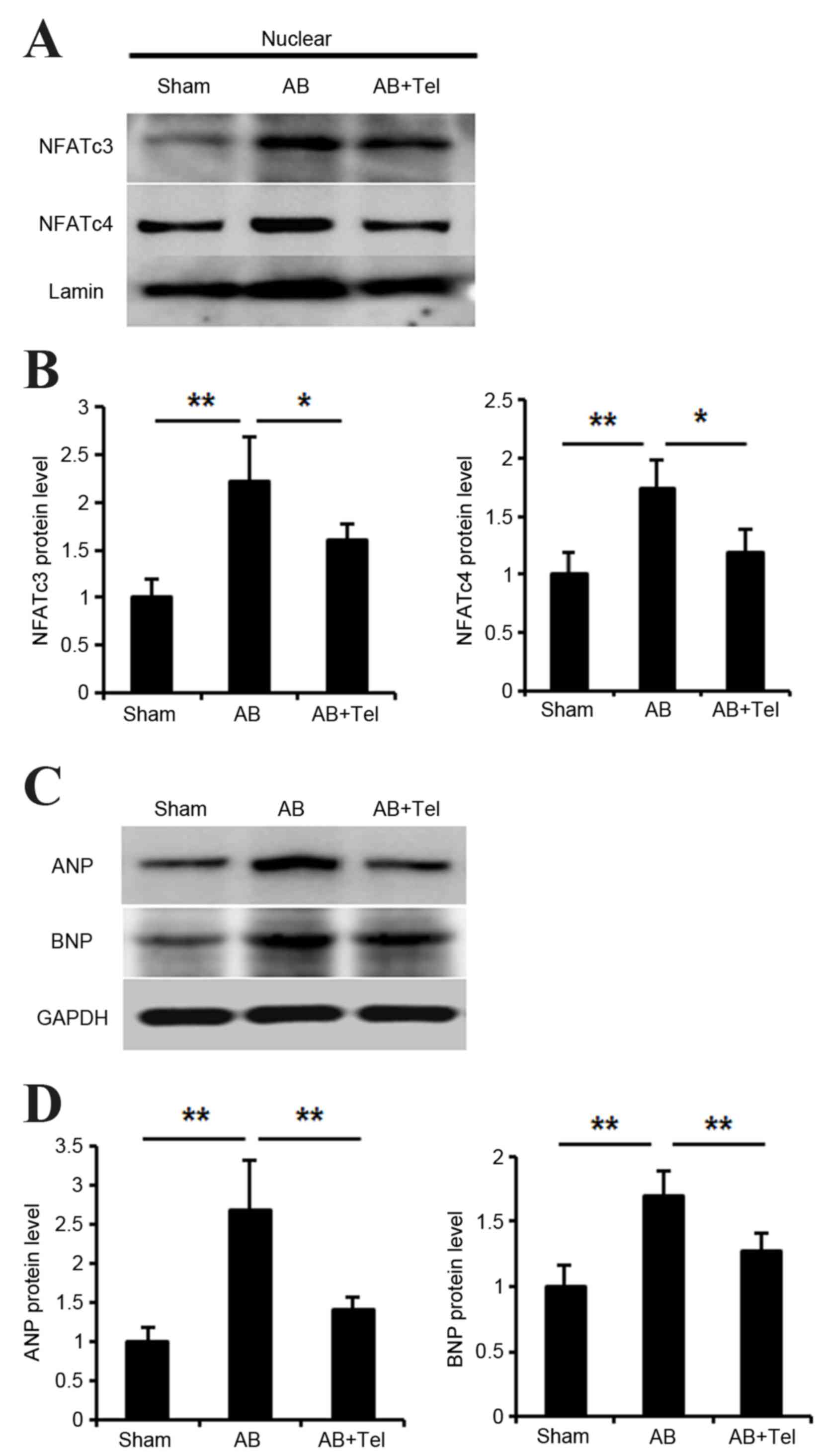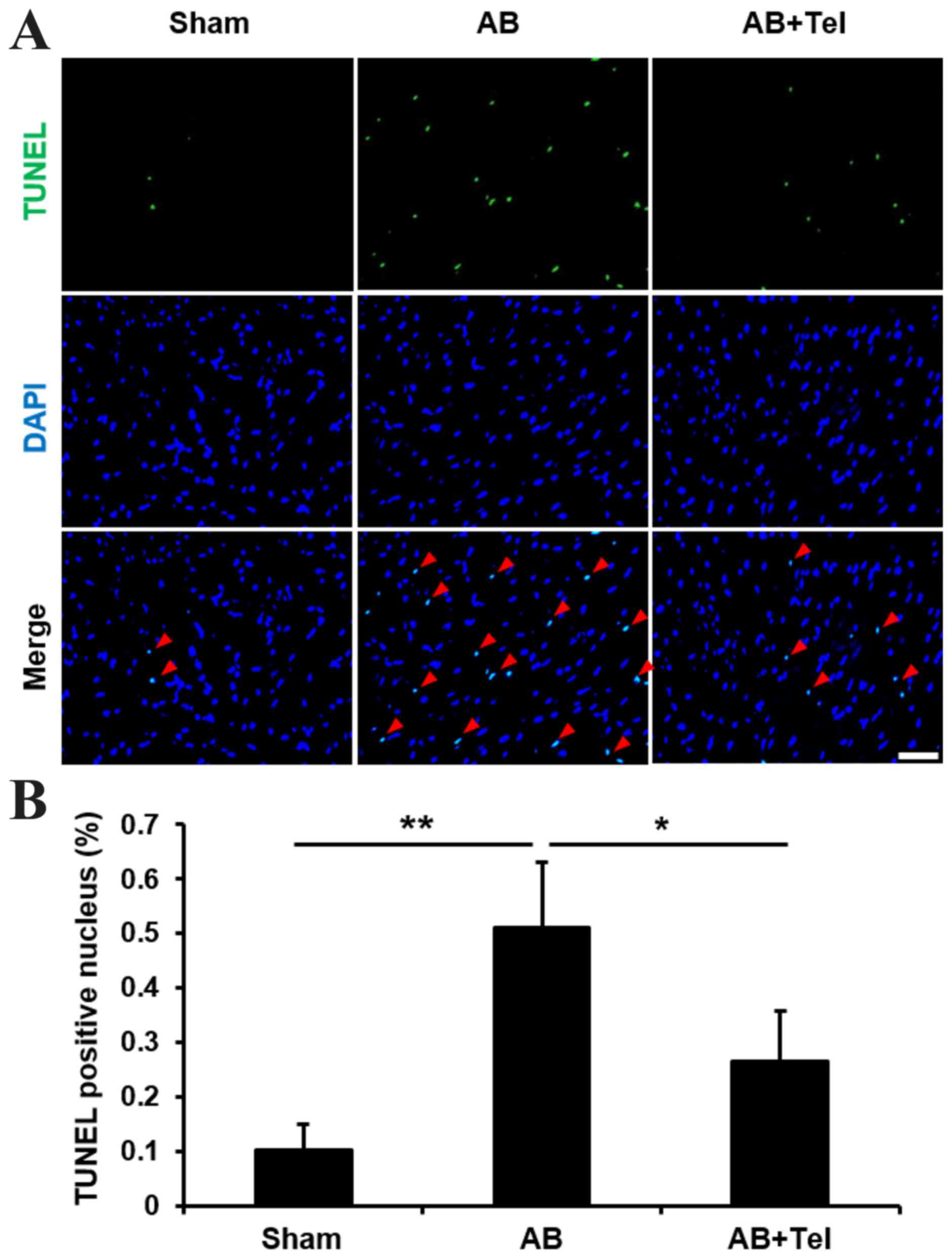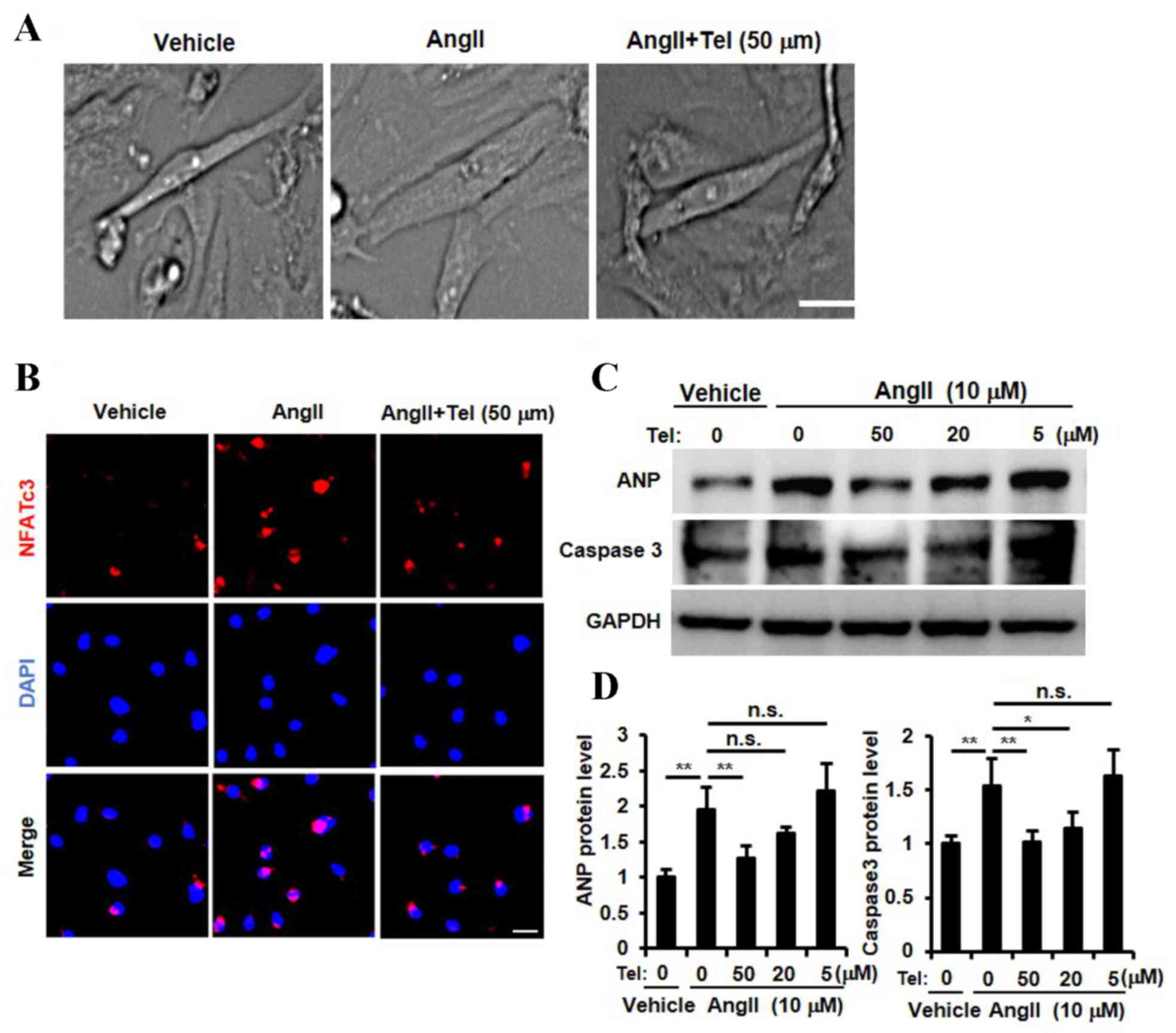|
1
|
Frohlich ED, Apstein C, Chobanian AV,
Devereux RB, Dustan HP, Dzau V, Fauad-Tarazi F, Horan MJ, Marcus M,
Massie B, et al: The heart in hypertension. N Engl J Med.
327:998–1008. 1992. View Article : Google Scholar : PubMed/NCBI
|
|
2
|
Curtiss C, Cohn JN, Vrobel T and Franciosa
JA: Role of the renin-angiotensin system in the systemic
vasoconstriction of chronic congestive heart failure. Circulation.
58:763–770. 1978. View Article : Google Scholar : PubMed/NCBI
|
|
3
|
McClellan KJ and Markham A: Telmisartan.
Drugs. 56:1039–1046. 1998. View Article : Google Scholar : PubMed/NCBI
|
|
4
|
Wienen W, Hauel N, Van Meel JC, Narr B,
Ries U and Entzeroth M: Pharmacological characterization of the
novel nonpeptide angiotensin II receptor antagonist, BIBR 277. Br J
Pharmacol. 110:245–252. 1993. View Article : Google Scholar : PubMed/NCBI
|
|
5
|
Amerena J, Pappas S, Ouellet JP, Williams
L and O'Shaughnessy D: ABPM comparison of the anti-hypertensive
profiles of telmisartan and enalapril in patients with
mild-to-moderate essential hypertension. J Int Med Res. 30:543–552.
2002. View Article : Google Scholar : PubMed/NCBI
|
|
6
|
Saha L: Comparison of the efficacy and
tolerability of telmisartan and enalapril in patients of mild to
moderate essential hypertension. Indian J Pharmacol. 43:3602011.
View Article : Google Scholar : PubMed/NCBI
|
|
7
|
Neutel JM, Littlejohn TW, Chrysant SG and
Singh A: Telmisartan Study Group: Telmisartan/Hydrochlorothiazide
in comparison with losartan/hydrochlorothiazide in managing
patients with mild-to-moderate hypertension. Hypertens Res.
28:555–563. 2005. View Article : Google Scholar : PubMed/NCBI
|
|
8
|
Wienen W and Entzeroth M: Effects on
binding characteristics and renal function of the novel,
non-peptide angiotensin II antagonist BIBR277 in the rat. J
Hypertens. 12:119–128. 1994. View Article : Google Scholar : PubMed/NCBI
|
|
9
|
Makino H, Haneda M, Babazono T, Moriya T,
Ito S, Iwamoto Y, Kawamori R, Takeuchi M and Katayama S: INNOVATION
Study Group: Prevention of transition from incipient to overt
nephropathy with telmisartan in patients with type 2 diabetes.
Diabetes Care. 30:1577–1578. 2007. View Article : Google Scholar : PubMed/NCBI
|
|
10
|
Derosa G, Ragonesi PD, Mugellini A,
Ciccarelli L and Fogari R: Effects of telmisartan compared with
eprosartan on blood pressure control, glucose metabolism and lipid
profile in hypertensive, type 2 diabetic patients: A randomized,
double-blind, placebo-controlled 12-month study. Hypertens Res.
27:457–464. 2004. View Article : Google Scholar : PubMed/NCBI
|
|
11
|
Honjo S, Nichi Y, Wada Y, Hamamoto Y and
Koshiyama H: Possible beneficial effect of telmisartan on glycemic
control in diabetic subjects. Diabetes Care. 28:4982005. View Article : Google Scholar : PubMed/NCBI
|
|
12
|
Nagel JM, Tietz AB, Göke B and Parhofer
KG: The effect of telmisartan on glucose and lipid metabolism in
nondiabetic, insulin-resistant subjects. Metabolism. 55:1149–1154.
2006. View Article : Google Scholar : PubMed/NCBI
|
|
13
|
Gohlke P, Weiss S, Jansen A, Wienen W,
Stangier J, Rascher W, Culman J and Unger T: AT1 receptor
antagonist telmisartan administered peripherally inhibits central
responses to angiotensin II in conscious rats. J Pharmacol Exp
Ther. 298:62–70. 2001.PubMed/NCBI
|
|
14
|
Mogi M, Li JM, Tsukuda K, Iwanami J, Min
LJ, Sakata A, Fujita T, Iwai M and Horiuchi M: Telmisartan
prevented cognitive decline partly due to PPAR-gamma activation.
Biochem Biophys Res Commun. 375:446–449. 2008. View Article : Google Scholar : PubMed/NCBI
|
|
15
|
Böhm M, Lippoldt A, Wienen W, Ganten D and
Bader M: Reduction of cardiac hypertrophy in TGR(mREN2)27 by
angiotensin II receptor blockade. Mol Cell Biochem.
163–164:217–221. 1996. View Article : Google Scholar
|
|
16
|
Mattioli AV, Zennaro M, Bonatti S, Bonetti
L and Mattioli G: Regression of left ventricular hypertrophy and
improvement of diastolic function in hypertensive patients treated
with telmisartan. Int J Cardiol. 97:383–388. 2004. View Article : Google Scholar : PubMed/NCBI
|
|
17
|
Maejima Y, Okada H, Haraguchi G, Onai Y,
Kosuge H, Suzuki J and Isobe M: Telmisartan, a unique ARB, improves
left ventricular remodeling of infarcted heart by activating PPAR
gamma. Lab Invest. 91:932–944. 2011. View Article : Google Scholar : PubMed/NCBI
|
|
18
|
Siragy H: Angiotensin II receptor
blockers: Review of the binding characteristics. Am J Cardiol.
84:3S–8S. 1999. View Article : Google Scholar : PubMed/NCBI
|
|
19
|
D'Ascenzi F, Pelliccia A, Corrado D,
Cameli M, Curci V, Alvino F, Natali BM, Focardi M, Bonifazi M and
Mondillo S: Right ventricular remodelling induced by exercise
training in competitive athletes. Eur Heart J Cardiovasc Imaging.
17:301–307. 2016. View Article : Google Scholar : PubMed/NCBI
|
|
20
|
Bernardo BC, Weeks KL, Pretorius L and
McMullen JR: Molecular distinction between physiological and
pathological cardiac hypertrophy: Experimental findings and
therapeutic strategies. Pharmacol Ther. 128:191–227. 2010.
View Article : Google Scholar : PubMed/NCBI
|
|
21
|
Heineke J and Molkentin JD: Regulation of
cardiac hypertrophy by intracellular signalling pathways. Nat Rev
Mol Cell Biol. 7:589–600. 2006. View
Article : Google Scholar : PubMed/NCBI
|
|
22
|
Irani RA, Zhang Y, Blackwell SC, Zhou CC,
Ramin SM, Kellems RE and Xia Y: The detrimental role of angiotensin
receptor agonistic autoantibodies in intrauterine growth
restriction seen in preeclampsia. J Exp Med. 206:2809–2822. 2009.
View Article : Google Scholar : PubMed/NCBI
|
|
23
|
Rockman HA, Ross RS, Harris AN, Knowlton
KU, Steinhelper ME, Field LJ, Ross J Jr and Chien KR: Segregation
of atrial-specific and inducible expression of an atrial
natriuretic factor transgene in an in vivo murine model of cardiac
hypertrophy. Proc Natl Acad Sci USA. 88:8277–8281. 1991. View Article : Google Scholar : PubMed/NCBI
|
|
24
|
Chlopcíková S, Psotová J and Miketová P:
Neonatal rat cardiomyocytes-a model for the study of morphological,
biochemical and electrophysiological characteristics of the heart.
Biomed Pap Med Fac Univ Palacky Olomouc Czech Repub. 145:49–55.
2001. View Article : Google Scholar : PubMed/NCBI
|
|
25
|
Livak KJ and Schmittgen TD: Analysis of
relative gene expression data using real-time quantitative PCR and
the 2(−Delta Delta C(T)) Method. Methods. 25:402–408. 2001.
View Article : Google Scholar : PubMed/NCBI
|
|
26
|
Molkentin JD: Calcineurin-NFAT signaling
regulates the cardiac hypertrophic response in coordination with
the MAPKs. Cardiovasc Res. 63:467–475. 2004. View Article : Google Scholar : PubMed/NCBI
|
|
27
|
Pu WT, Ma Q and Izumo S: NFAT
transcription factors are critical survival factors that inhibit
cardiomyocyte apoptosis during phenylephrine stimulation in vitro.
Circ Res. 92:725–731. 2003. View Article : Google Scholar : PubMed/NCBI
|
|
28
|
Tokudome T, Horio T, Kishimoto I, Soeki T,
Mori K, Kawano Y, Kohno M, Garbers DL, Nakao K and Kangawa K:
Calcineurin-nuclear factor of activated T cells pathway-dependent
cardiac remodeling in mice deficient in guanylyl cyclase A, a
receptor for atrial and brain natriuretic peptides. Circulation.
111:3095–3104. 2005. View Article : Google Scholar : PubMed/NCBI
|
|
29
|
Liang F, Lu S and Gardner DG:
Endothelin-dependent and -independent components of
strain-activated brain natriuretic peptide gene transcription
require extracellular signal regulated kinase and p38
mitogen-activated protein kinase. Hypertension. 35:188–192. 2000.
View Article : Google Scholar : PubMed/NCBI
|
|
30
|
Wu CF, Bishopric NH and Pratt RE: Atrial
natriuretic peptide induces apoptosis in neonatal rat cardiac
myocytes. J Biol Chem. 272:14860–14866. 1997. View Article : Google Scholar : PubMed/NCBI
|
|
31
|
Suenobu N, Shichiri M, Iwashina M, Marumo
F and Hirata Y: Natriuretic peptides and nitric oxide induce
endothelial apoptosis via a cGMP-dependent mechanism. Arterioscler
Thromb Vasc Biol. 19:140–146. 1999. View Article : Google Scholar : PubMed/NCBI
|
|
32
|
Diep QN, El Mabrouk M, Yue P and Schiffrin
EL: Effect of AT(1) receptor blockade on cardiac apoptosis in
angiotensin II-induced hypertension. Am J Physiol Heart Circ
Physiol. 282:H1635–H1641. 2002. View Article : Google Scholar : PubMed/NCBI
|
|
33
|
Porter AG and Jänicke RU: Emerging roles
of caspase-3 in apoptosis. Cell Death Differ. 6:99–104. 1999.
View Article : Google Scholar : PubMed/NCBI
|
|
34
|
Telmisartan Randomised AssessmeNt Study in
ACE iNtolerant subjects with cardiovascular Disease (TRANSCEND)
Investigators. Yusuf S, Teo K, Anderson C, Pogue J, Dyal L, Copland
I, Schumacher H, Dagenais G and Sleight P: Effects of the
angiotensin-receptor blocker telmisartan on cardiovascular events
in high-risk patients intolerant to angiotensin-converting enzyme
inhibitors: A randomised controlled trial. Lancet. 372:1174–1183.
2008. View Article : Google Scholar : PubMed/NCBI
|
|
35
|
Zou Y, Akazawa H, Qin Y, Sano M, Takano H,
Minamino T, Makita N, Iwanaga K, Zhu W, Kudoh S, et al: Mechanical
stress activates angiotensin II type 1 receptor without the
involvement of angiotensin II. Nat Cell Biol. 6:499–506. 2004.
View Article : Google Scholar : PubMed/NCBI
|
|
36
|
Li L, Zhou N, Gong H, Wu J, Lin L, Komuro
I, Ge J and Zou Y: Comparison of angiotensin II type 1-receptor
blockers to regress pressure overload-induced cardiac hypertrophy
in mice. Hypertens Res. 33:1289–1297. 2010. View Article : Google Scholar : PubMed/NCBI
|
|
37
|
Chang WH, Yan JJ, Li X, Guo HY and Liu Y:
Effects of telmisartan on angiotensin II-induced cardiomyocyte
hypertrophy and p-ERK1/2 phosphorylation in
rat cultured cardiomyocytes. Asian Biomed. 5:459–465. 2011.
|
|
38
|
Muller P, Kazakov A, Semenov A, Jagoda P,
Friedrich EB, Böhm M and Laufs U: Ramipril and telmisartan exhibit
differential effects in cardiac pressure overload-induced
hypertrophy without an additional benefit of the combination of
both drugs. J Cardiovasc Pharmacol Ther. 18:87–93. 2013. View Article : Google Scholar : PubMed/NCBI
|
|
39
|
Wilkins BJ, Dai YS, Bueno OF, Parsons SA,
Xu J, Plank DM, Jones F, Kimball TR and Molkentin JD:
Calcineurin/NFAT coupling participates in pathological, but not
physiological, cardiac hypertrophy. Circ Res. 94:110–118. 2004.
View Article : Google Scholar : PubMed/NCBI
|
|
40
|
Sanna B, Bueno OF, Dai YS, Wilkins BJ and
Molkentin JD: Direct and indirect interactions between
calcineurin-NFAT and MEK1-extracellular signal-regulated kinase 1/2
signaling pathways regulate cardiac gene expression and cellular
growth. Mol Cell Biol. 25:865–878. 2005. View Article : Google Scholar : PubMed/NCBI
|
|
41
|
Robbs BK, Lucena PI and Viola JP: The
transcription factor NFAT1 induces apoptosis through cooperation
with Ras/Raf/MEK/ERK pathway and upregulation of TNF-α expression.
Biochim Biophys Acta. 1833:2016–2028. 2013. View Article : Google Scholar : PubMed/NCBI
|
|
42
|
Yamagishi S and Takeuchi M: Telmisartan is
a promising cardiometabolic sartan due to its unique
PPAR-gamma-inducing property. Med Hypotheses. 64:476–478. 2005.
View Article : Google Scholar : PubMed/NCBI
|
|
43
|
Bao Y, Li R, Jiang J, Cai B, Gao J, Le K,
Zhang F, Chen S and Liu P: Activation of peroxisome
proliferator-activated receptor gamma inhibits endothelin-1-induced
cardiac hypertrophy via the calcineurin/NFAT signaling pathway. Mol
Cell Biochem. 317:189–196. 2008. View Article : Google Scholar : PubMed/NCBI
|
|
44
|
Molkentin JD, Lu JR, Antos CL, Markham B,
Richardson J, Robbins J, Grant SR and Olson EN: A
calcineurin-dependent transcriptional pathway for cardiac
hypertrophy. Cell. 93:215–228. 1998. View Article : Google Scholar : PubMed/NCBI
|













